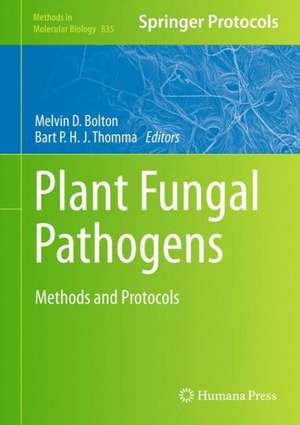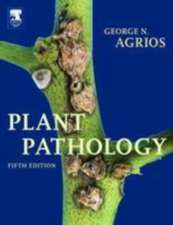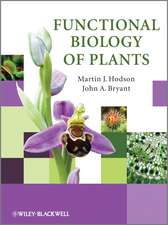Plant Fungal Pathogens: Methods and Protocols: Methods in Molecular Biology, cartea 835
Editat de Melvin D. Bolton, Bart P. H. J. Thommaen Limba Engleză Hardback – 21 dec 2011
Authoritative and practical, Plant Fungal Pathogens: Methods and Protocols seeks to aid scientists in the further study in current techniques that cover a wide-range of methods to study molecular aspects of pathogenesis.
| Toate formatele și edițiile | Preț | Express |
|---|---|---|
| Paperback (1) | 1018.51 lei 6-8 săpt. | |
| Humana Press Inc. – 23 aug 2016 | 1018.51 lei 6-8 săpt. | |
| Hardback (1) | 1248.83 lei 6-8 săpt. | |
| Humana Press Inc. – 21 dec 2011 | 1248.83 lei 6-8 săpt. |
Din seria Methods in Molecular Biology
- 9%
 Preț: 791.63 lei
Preț: 791.63 lei - 23%
 Preț: 598.58 lei
Preț: 598.58 lei - 20%
 Preț: 882.98 lei
Preț: 882.98 lei -
 Preț: 252.05 lei
Preț: 252.05 lei - 5%
 Preț: 802.70 lei
Preț: 802.70 lei - 5%
 Preț: 729.61 lei
Preț: 729.61 lei - 5%
 Preț: 731.43 lei
Preț: 731.43 lei - 5%
 Preț: 741.30 lei
Preț: 741.30 lei - 5%
 Preț: 747.16 lei
Preț: 747.16 lei - 15%
 Preț: 663.45 lei
Preț: 663.45 lei - 18%
 Preț: 1025.34 lei
Preț: 1025.34 lei - 5%
 Preț: 734.57 lei
Preț: 734.57 lei - 18%
 Preț: 914.20 lei
Preț: 914.20 lei - 15%
 Preț: 664.61 lei
Preț: 664.61 lei - 15%
 Preț: 654.12 lei
Preț: 654.12 lei - 18%
 Preț: 1414.74 lei
Preț: 1414.74 lei - 5%
 Preț: 742.60 lei
Preț: 742.60 lei - 20%
 Preț: 821.65 lei
Preț: 821.65 lei - 18%
 Preț: 972.30 lei
Preț: 972.30 lei - 15%
 Preț: 660.49 lei
Preț: 660.49 lei - 5%
 Preț: 738.41 lei
Preț: 738.41 lei - 18%
 Preț: 984.92 lei
Preț: 984.92 lei - 5%
 Preț: 733.29 lei
Preț: 733.29 lei -
 Preț: 392.60 lei
Preț: 392.60 lei - 5%
 Preț: 746.26 lei
Preț: 746.26 lei - 18%
 Preț: 962.66 lei
Preț: 962.66 lei - 23%
 Preț: 860.22 lei
Preț: 860.22 lei - 15%
 Preț: 652.64 lei
Preț: 652.64 lei - 5%
 Preț: 1055.50 lei
Preț: 1055.50 lei - 23%
 Preț: 883.87 lei
Preț: 883.87 lei - 5%
 Preț: 1141.13 lei
Preț: 1141.13 lei - 19%
 Preț: 491.89 lei
Preț: 491.89 lei - 5%
 Preț: 1038.86 lei
Preț: 1038.86 lei - 5%
 Preț: 524.16 lei
Preț: 524.16 lei - 18%
 Preț: 2122.34 lei
Preț: 2122.34 lei - 5%
 Preț: 1299.23 lei
Preț: 1299.23 lei - 5%
 Preț: 1339.12 lei
Preț: 1339.12 lei - 18%
 Preț: 1390.26 lei
Preț: 1390.26 lei - 18%
 Preț: 1395.63 lei
Preț: 1395.63 lei - 18%
 Preț: 1129.65 lei
Preț: 1129.65 lei - 18%
 Preț: 1408.26 lei
Preț: 1408.26 lei - 18%
 Preț: 1124.92 lei
Preț: 1124.92 lei - 18%
 Preț: 966.27 lei
Preț: 966.27 lei - 5%
 Preț: 1299.99 lei
Preț: 1299.99 lei - 5%
 Preț: 1108.51 lei
Preț: 1108.51 lei - 5%
 Preț: 983.76 lei
Preț: 983.76 lei - 5%
 Preț: 728.16 lei
Preț: 728.16 lei - 18%
 Preț: 1118.62 lei
Preț: 1118.62 lei - 18%
 Preț: 955.25 lei
Preț: 955.25 lei - 5%
 Preț: 1035.62 lei
Preț: 1035.62 lei
Preț: 1248.83 lei
Preț vechi: 1522.96 lei
-18% Nou
Puncte Express: 1873
Preț estimativ în valută:
238.99€ • 259.51$ • 200.75£
238.99€ • 259.51$ • 200.75£
Carte tipărită la comandă
Livrare economică 22 aprilie-06 mai
Preluare comenzi: 021 569.72.76
Specificații
ISBN-13: 9781617795008
ISBN-10: 1617795003
Pagini: 648
Ilustrații: XVI, 648 p.
Dimensiuni: 178 x 254 x 41 mm
Greutate: 1.34 kg
Ediția:2012
Editura: Humana Press Inc.
Colecția Humana
Seria Methods in Molecular Biology
Locul publicării:Totowa, NJ, United States
ISBN-10: 1617795003
Pagini: 648
Ilustrații: XVI, 648 p.
Dimensiuni: 178 x 254 x 41 mm
Greutate: 1.34 kg
Ediția:2012
Editura: Humana Press Inc.
Colecția Humana
Seria Methods in Molecular Biology
Locul publicării:Totowa, NJ, United States
Public țintă
Professional/practitionerCuprins
Fungal ABC Transporter Deletion and Localization Analysis.- Targeted Gene Replacement in Fungal Pathogens via Agrobacterium tumefaciens Mediated Transformation.- Activity-based Protein Profiling of Infected Plants.- The use of Agroinfiltration for Transient Expression of Plant Resistance and Fungal Effector Proteins in Nicotiana benthamiana Leaves.- Proteomic Techniques for Plant-Fungal Interactions.- Identification of HR-inducing cDNAs from Plant Pathogens via a Gateway®-Compatible Binary Potato Virus X-Expression Vector.- Freeze-Fracture of Infected Plant Leaves in Ethanol for Scanning Electron Microscopic Study of Fungal Pathogens.- Real-time PCR for the Quantification of Fungi in planta.- Using Non-homologous End-joining-deficient Strains for Functional Gene Analyses in Filamentous Fungi.- Atomic Force Microscopy (AFM): A Tool for Studying Biophysical Surface Properties Underpinning Fungal Interactions with Plants and Substrates.- Use of the Yeast Two-Hybrid System to Identify Targets of Fungal Effectors.- Characterization of Plant – Fungal Interactions Involving Necrotrophic Effector-Producing Plant Pathogens.- Heterologous Production of Fungal Effectors in Pichia pastoris.- The Application of Laser Microdissection to Profiling Fungal Pathogen Gene Expression in planta.- Metabolomics Protocols for Filamentous Fungi.- Targeted Gene Replacement in Fungi Using a Split-Marker Approach.- Massively Parallel Sequencing Technology in Pathogenic Microbes.- Confocal Microscopy in Plant Pathogen Interactions.- The use of Open Source Bioinformatics Tools to Dissect Transcriptomic Data.- Population Biology of Fungal Plant Pathogens.- Polyethylene Glycol (PEG)-mediated Transformation in Filamentous Fungal Pathogens.- In vitro Induction of Infection-related Hyphal Structures in Plant Pathogenic Fungi.- Fungicide Resistance Assays for Fungal Plant Pathogens.- Identification ofLipid-binding Effectors.- In silico Identification and Characterization of Effector Catalogs.- Horizontal Transfer of Supernumerary Chromosomes in Fungi.- The Induction of Mycotoxins by Trichothecene Producing Fusarium Species.- Identifying Genes in Fusarium verticillioides Through Forward and Reverse Genetics.- Assessment of Autophagosome Formation by Transmission Electron Microscopy (TEM).- Fungal Plant Pathogen Detection in Plant and Soil Samples using DNA Macroarrays.- Random Insertional Mutagenesis in Fungal Genomes to Identify Virulence Factors.- A Yeast-Secretion Trap Assay for Identification of Secreted Proteins from Eukaryotic Phytopathogens and their Plant Hosts.- Comparing Fungal Genomes: Insight into Functional and Evolutionary Processes.- Multi-gene Phylogenetic Analyses to Delimit New Species in Fungal Plant Pathogens.- MAP Kinase Phosphorylation and cAMP Assessment in Fungi.- A One-step Affinity-purification Protocol to Purify NB-LRR Immune Receptors from Plants that Mediate Resistance to Fungal Pathogens.- Karyotyping Methods for Fungi.- Isolation of Apoplastic Fluid from Leaf Tissue by the Vacuum Infiltration-Centrifugation Technique.- Gene Cloning using Degenerate Primers and Genome Walking.- Construction of Hairpin RNA Expressing Vectors for RNA-mediated Gene Silencing in Fungi.- An Unbiased Method for the Quantitation of Disease Phenotypes using a Custom-built Macro Plugin for the Program ImageJ.
Recenzii
From the reviews:
“The authors provide the latest information on topics including methods in molecular biology and highlighting some of the latest techniques critical for students pursuing molecular plant pathology. … All the chapters are well illustrated with charts and graphs and with necessary photographs. … should be available in school libraries experienced fungal research laboratories and university libraries. This is specially aimed at researchers new to the molecular biology field.” (Asha Janadaree Dissanayake and Kevin D. Hyde, Fungal Diversity, Vol. 59, March, 2013)
“The current volume is a unique collection of 41 chapters from a diverse group of scientists, researchers, and academics working on different aspects of the molecular basis of fungal pathogens and pathogenesis. … This volume will be useful for both students and researchers in the fields of botany and forestry, agriculture, mycology, microbiology, plant disease and diagnostics, molecular plant pathology, horticulture science, biomolecular sciences, life sciences, fungal molecular biology, fungal biotechnology, microbial biotechnology, and food technology.” (S. K. Basu, Plant Science Bulletin, Vol. 59 (1), 2013)
“The authors provide the latest information on topics including methods in molecular biology and highlighting some of the latest techniques critical for students pursuing molecular plant pathology. … All the chapters are well illustrated with charts and graphs and with necessary photographs. … should be available in school libraries experienced fungal research laboratories and university libraries. This is specially aimed at researchers new to the molecular biology field.” (Asha Janadaree Dissanayake and Kevin D. Hyde, Fungal Diversity, Vol. 59, March, 2013)
“The current volume is a unique collection of 41 chapters from a diverse group of scientists, researchers, and academics working on different aspects of the molecular basis of fungal pathogens and pathogenesis. … This volume will be useful for both students and researchers in the fields of botany and forestry, agriculture, mycology, microbiology, plant disease and diagnostics, molecular plant pathology, horticulture science, biomolecular sciences, life sciences, fungal molecular biology, fungal biotechnology, microbial biotechnology, and food technology.” (S. K. Basu, Plant Science Bulletin, Vol. 59 (1), 2013)
Textul de pe ultima copertă
Over the course of evolution, fungi have adapted to occupy specific niches, from symbiotically inhabiting the flora of the intestinal tract of mammals to saprophytic growth on leaf litter resting on the forest floor. In Plant Fungal Pathogens: Methods and Protocols, expert researchers in the field detail many of the methods which are now commonly used to study fungal plant pathogens. These include methods and techniques for model systems such as Arabidopsis thaliana as well as crop plants, aspects of fungal biology, genome annotation, next-generation sequencing, and fungal transformation and molecular tools for disease and/or pathogen quantification that are critical for revealing the role for a fungal gene of interest in disease development. Written in the highly successful Methods in Molecular Biology™ series format, chapters include introductions to their respective topics, lists of the necessary materials and reagents, step-by-step, readily reproducible laboratory protocols, and key tips on troubleshooting and avoiding known pitfalls.
Authoritative and practical, Plant Fungal Pathogens: Methods and Protocols seeks to aid scientists in the further study in current techniques that cover a wide-range of methods to study molecular aspects of pathogenesis.
Authoritative and practical, Plant Fungal Pathogens: Methods and Protocols seeks to aid scientists in the further study in current techniques that cover a wide-range of methods to study molecular aspects of pathogenesis.
Caracteristici
Highlights the latest techniques for the study of molecular plant pathology Provides step-by-step detail essential for reproducible results Contains key notes an implementation advice from the experts






